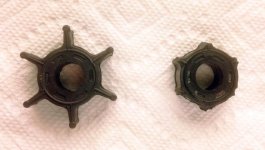Atlanta Boat Guy
New member
I have a 9.9 HP, 2006 Honda with apparently about 5 to 10 hours on it, per the original owner. It looks absolutely brand new outside and under the cowl. It seems the engine was used a handful of times and then stored-- never serviced in any way, I was told. I'm not at all comfortable with a 10-year-old impeller, no matter how few hours are on it, and when it was briefly test cranked, I was not impressed with the water stream. It could be we never revved it enough to pump well, but I didn't want to chance it.
Here's my question-- the Honda shop manual says to pull the prop off as well as to remove the prop shaft and I'm, wondering why? You have to disconnect the shift linkage above the gear case assembly. Instructions I see on youtube videos etc., show that removal of the prop shaft isn't needed on similar motors, including some Honda motors.
I'm willing to do what is needed but would rather avoid disassembling anything unnecessarily.
Here's my question-- the Honda shop manual says to pull the prop off as well as to remove the prop shaft and I'm, wondering why? You have to disconnect the shift linkage above the gear case assembly. Instructions I see on youtube videos etc., show that removal of the prop shaft isn't needed on similar motors, including some Honda motors.
I'm willing to do what is needed but would rather avoid disassembling anything unnecessarily.


